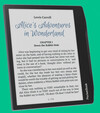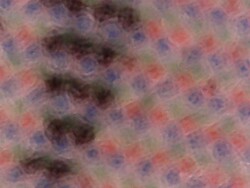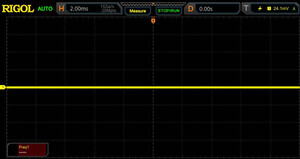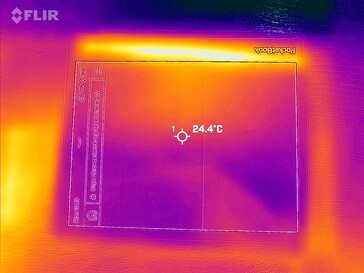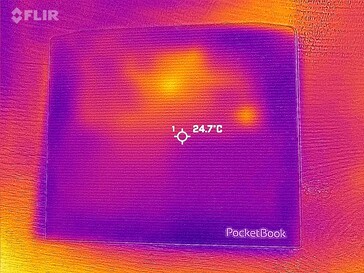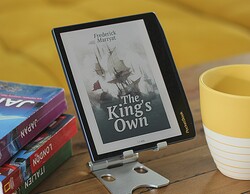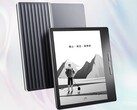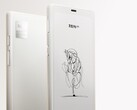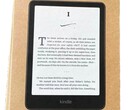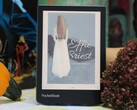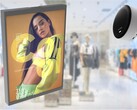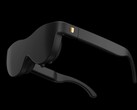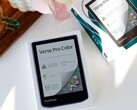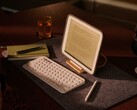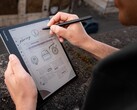PocketBook Era Color review – The compact color e-reader
Possible competitors compared
Rating | Date | Model | Weight | Drive | Size | Resolution | Price from |
|---|---|---|---|---|---|---|---|
| 75.4 % v7 (old) | 05 / 2024 | PocketBook Era Color unknown, unknown | 235 g | 32 GB eMMC Flash | 7.00" | 840x632 | |
| 75.7 % v7 (old) | 12 / 2023 | PocketBook InkPad Color 3 unknown, unknown | 269 g | 32 GB eMMC Flash | 7.80" | 936x702 | |
| 77.2 % v7 (old) | 12 / 2023 | Onyx Boox Page SD 662, Adreno 610 | 195 g | 32 GB eMMC Flash | 7.00" | 1682x1264 | |
| 77.5 % v7 (old) | 11 / 2023 | Onyx Boox Note Air 3 C SD 680, Adreno 610 | 430 g | 64 GB UFS 2.1 Flash | 10.30" | 1240x930 |
Case and connectivity – A simple plastic case with a surprise
For PocketBook fans, the e-reader's somewhat plain case is instantly recognizable thanks to its tactile stripe print on the back. The color is called Stormy Sea—we would say that it consists of dark gray tones. The case is made from plastic and has been built well, however, the back can be dented slightly with pressure applied.
The operating buttons are housed along the e-reader's long side—which also features a slightly wider case frame that allows readers to hold the device comfortably without accidentally activating the touchscreen. Weighing in at only 195 grams with a small footprint, the Era Color is very portable and can easily fit into even smaller bags.
If the e-reader accidentally falls into a lake during a swimming trip, then don't worry: The Era Color is protected according to IPX8, meaning it can be submerged into freshwater for several minutes.
For an e-reader, 1 GB RAM should be sufficient. However, if you like to surf the web a lot, then you just need to make sure not to accidentally exit the browser: Due to the device's small amount of RAM, the application isn't kept open in the background, so it will be restarted every time you go back to it.
32 GB of storage gives users enough space for e-books and you can also make use of the PocketBook Cloud to store additional content online. Unfortunately, you can't insert any microSD cards for storage expansion or transferring files. Furthermore, the reader is a little picky when it comes to which cables allow the device to be recognized and files to be transferred when connecting it to the PC via its USB-C port.
What we like a lot: Behind a flap on the back lie several Pogo pins which you can use to connect accessories to the reader. This includes a charging cover, for example, which lets you charge the device wirelessly.
Communication, software and operation – Including an e-book shop
The Era Color isn't super fast at surfing the web: WiFi 4 is the fastest standard it supports. This only results in speeds of around 55 MBit/s which may be enough for downloading regular books but if you are downloading larger audio books, this might take a while.
Its software is based on Linux which has its advantages and disadvantages over Android: You can use the directly integrated store, as the manufacturer doesn't have to pay Google any fees (unlike with Android). This store offers an extensive selection including the latest releases in many languages. At the same time, you can't install any apps to expand the e-reader's functions.
Apart from reading e-books, you can take notes and surf the web—plus, you can also access a calendar, an RSS newsreader and an app which lets you use the device as a digital photo frame. Online borrowing for libraries is also supported. You can send e-books to the device via Dropbox, the in-house PocketBook Cloud or directly via email. Several games and a drawing function also come preinstalled.
You can operate the e-reader via its touchscreen, although it reacts somewhat slowly at times. This is partly due to the e-ink technology which takes time to load content, and it is also to do with the Era Color's limited performance capabilities.
Aside from the screen, users can also operate the reader via four hardware buttons: You can flip through the menu and—more importantly—through books, activate standby mode or exit back to the home screen. Haptically, the buttons could do with being separated better and their labelling isn't tactile—nor is it particularly visible.
| Networking | |
| PocketBook Era Color | |
| iperf3 transmit AXE11000 | |
| iperf3 receive AXE11000 | |
| PocketBook InkPad Color 3 | |
| iperf3 transmit AXE11000 | |
| iperf3 receive AXE11000 | |
| Onyx Boox Page | |
| iperf3 transmit AXE11000 | |
| iperf3 receive AXE11000 | |
| Onyx Boox Note Air 3 C | |
| iperf3 transmit AXE11000 | |
| iperf3 receive AXE11000 | |
E-reading – Lots of formats and functions
The PocketBook Era Color supports a variety of formats, including the electronic comic formats CBR and CBZ. The Kindle AZW and AZW 3 formats can also be read, but only if the content is not copy-protected. You can also read e-books in the following formats: ACSM, CHM, DJVU, DOC, DOCX, EPUB, EPUB(DRM), FB2, FB2.ZIP, HTM, HTML, MOBI, PDF, PDF (DRM), PRC, RTF and TXT.
If you click on a book, the preinstalled e-reading software starts automatically, allowing you to make extensive adjustments to your reading experience: you can select the line spacing in three steps and also how large the gap to the edge of the screen should be. If words are not to be separated, this can also be selected.
You can choose between a good 20 fonts and have some of them displayed in italics or bold. The number of pages displayed can also be configured or hidden completely. You can make notes or look up a term in the dictionary if you don't know it.
If desired, the text can be read aloud in 26 different languages using speech synthesis. You shouldn't expect quality on a par with a professional audiobook, the intonations are often incorrect and the system also struggles with newly created words. But it is a good feature for accessibility and as an emergency solution.
Display – Bright illumination on the color display
The 7-inch display with a 4:3 aspect ratio makes for a handy e-reader. However, those who prefer large fonts will find it easier to use a display with more space, as you will have to turn the pages quite frequently on the Era Color.
The display is based on the Kaleido 3 panel from E-Ink—it can display 4,096 color levels and 16 gray levels. Its resolution depends on what is being displayed: 1,872 x 1,404 pixels are possible for grayscale, while only half is available for color display.
This is also due to the special technology used within E-Ink displays, as tiny ink particles are actually brought into position by electric charges. Color filters are used for different color tones, which reduce the resolution. The e-reader's color display is of average strength, but we found it more intense on the InkPad Color 3.
An e-ink display needs lighting so that you can also read in poor lighting conditions. With the PocketBook Era Color, this can be as bright as 92 cd/m², which is definitely sufficient. Both color temperature and brightness can be adjusted in many levels or automatically regulated by the device.
There is no need to worry about PWM flickering due to the technology used, and we did not see any of this in our test using an oscilloscope, either. Once an image has been created, it remains visible on the screen without requiring any additional power, which is easy on the eyes and the reader's battery.
However, e-ink displays also have their disadvantages: only relatively few color nuances can be displayed. Pages take a comparatively long time to load, making moving images almost impossible to view and its response to inputs is slow. From time to time, remnants of the previous image remain on the screen and can still be seen as shadows.
| |||||||||||||||||||||||||
Brightness Distribution: 91 %
Contrast: ∞:1 (Black: 0 cd/m²)
| PocketBook Era Color E-Ink Kaleido 3, 840x632, 7" | PocketBook InkPad Color 3 E-Ink, 936x702, 7.8" | Onyx Boox Page E-Ink, 1682x1264, 7" | Onyx Boox Note Air 3 C E-Ink Kaleido 3, 1240x930, 10.3" | |
|---|---|---|---|---|
| Response Times | ||||
| Response Time Grey 50% / Grey 80% * (ms) | 120 ? | 121 ? | ||
| Response Time Black / White * (ms) | 116 ? | 89.3 ? | ||
| PWM Frequency (Hz) | ||||
| Screen | -14% | 35% | -32% | |
| Brightness middle (cd/m²) | 92 | 75 -18% | 141 53% | 46.5 -49% |
| Brightness (cd/m²) | 88 | 77 -12% | 141 60% | 47 -47% |
| Brightness Distribution (%) | 91 | 81 -11% | 85 -7% | 91 0% |
| Black Level * (cd/m²) | ||||
| Colorchecker dE 2000 * | 20.45 | |||
| Colorchecker dE 2000 max. * | 39.33 | |||
| Greyscale dE 2000 * | 11.1 | |||
| Gamma | 1.211 182% | |||
| CCT | 6463 101% | |||
| Total Average (Program / Settings) | -14% /
-14% | 35% /
35% | -32% /
-32% |
* ... smaller is better
Screen Flickering / PWM (Pulse-Width Modulation)
| Screen flickering / PWM not detected | |||
In comparison: 53 % of all tested devices do not use PWM to dim the display. If PWM was detected, an average of 8098 (minimum: 5 - maximum: 343500) Hz was measured. | |||
Performance, emissions and battery life – Read for ages on the compact device
We can hardly objectively determine how powerful the PocketBook Era Color is, as only browser benchmarks run on the proprietary Linux system. However, they revealed that other e-readers offer much more power at times. This device uses a quad-core processor which provides 4 x 1.8 GHz of computing speed. However, the manufacturer does not specify which model is used.
We have come across faster page loading on e-readers but if you mainly want to read on the Era Color, then it will provide sufficient performance. In turn, you will notice that the Era Color often lags behind and you have to allow for waiting times—especially in the browser app and when entering text.
There is no need to worry about its case heating up noticeably; even after longer periods of use, we noted barely any increase in temperatures.
The speaker on the bottom edge allows you to listen to audio books and music. Voices are reproduced clearly, but they always sound a little distant. Unfortunately, it is lacking depth and bass for a full sound. Headphones or speakers can be connected either via the USB-C port (and possibly an appropriate adapter) or via Bluetooth. The transmitted sound signal is clear.
At 2,500 mAh, its battery is not terribly powerful for the size of the reader. Nevertheless, it enables 14:46 hours of reading at low screen brightness levels. Charging via a cable takes its time: You'll have to plan in a maximum of 2:30 hours for a full charge. The wireless charging times are even longer.
| Octane V2 - Total Score | |
| Average of class Tablet (763 - 138481, n=95, last 2 years) | |
| Onyx Boox Page | |
| Onyx Boox Note Air 3 C | |
| PocketBook Era Color | |
| Average unknown (2672 - 2794, n=3) | |
| PocketBook InkPad Color 3 | |
| Mozilla Kraken 1.1 - Total | |
| PocketBook Era Color | |
| Average unknown (14670 - 14953, n=2) | |
| Average of class Tablet (243 - 27101, n=80, last 2 years) | |
* ... smaller is better
Temperature
(+) The maximum temperature on the upper side is 29.5 °C / 85 F, compared to the average of 33.7 °C / 93 F, ranging from 20.7 to 53.2 °C for the class Tablet.
(+) The bottom heats up to a maximum of 28.9 °C / 84 F, compared to the average of 33.2 °C / 92 F
(+) In idle usage, the average temperature for the upper side is 22.8 °C / 73 F, compared to the device average of 30 °C / 86 F.
Speaker
PocketBook Era Color audio analysis
(±) | speaker loudness is average but good (76.1 dB)
Bass 100 - 315 Hz
(-) | nearly no bass - on average 27.2% lower than median
(±) | linearity of bass is average (7.3% delta to prev. frequency)
Mids 400 - 2000 Hz
(±) | higher mids - on average 7% higher than median
(±) | linearity of mids is average (11.1% delta to prev. frequency)
Highs 2 - 16 kHz
(±) | higher highs - on average 6.7% higher than median
(±) | linearity of highs is average (10.8% delta to prev. frequency)
Overall 100 - 16.000 Hz
(-) | overall sound is not linear (30.4% difference to median)
Compared to same class
» 89% of all tested devices in this class were better, 3% similar, 8% worse
» The best had a delta of 7%, average was 20%, worst was 129%
Compared to all devices tested
» 88% of all tested devices were better, 3% similar, 9% worse
» The best had a delta of 4%, average was 24%, worst was 134%
Onyx Boox Note Air 3 C audio analysis
(+) | speakers can play relatively loud (82.5 dB)
Bass 100 - 315 Hz
(-) | nearly no bass - on average 34.6% lower than median
(±) | linearity of bass is average (9.8% delta to prev. frequency)
Mids 400 - 2000 Hz
(±) | higher mids - on average 7.6% higher than median
(±) | linearity of mids is average (7.8% delta to prev. frequency)
Highs 2 - 16 kHz
(±) | higher highs - on average 7.8% higher than median
(±) | linearity of highs is average (7.7% delta to prev. frequency)
Overall 100 - 16.000 Hz
(-) | overall sound is not linear (32.8% difference to median)
Compared to same class
» 93% of all tested devices in this class were better, 1% similar, 6% worse
» The best had a delta of 7%, average was 20%, worst was 129%
Compared to all devices tested
» 92% of all tested devices were better, 1% similar, 7% worse
» The best had a delta of 4%, average was 24%, worst was 134%
Runtimes
| Battery runtime - Reader / Idle | |
| Average of class Tablet (11.5 - 53.1, n=55, last 2 years) | |
| PocketBook Era Color | |
| PocketBook InkPad Color 3 | |
| Onyx Boox Page | |
| Onyx Boox Note Air 3 C | |
Pros
Cons
Verdict – A small e-reader with some unique features
The PocketBook Era Color is the right choice for all fans of comics and books with lots of illustrations, such as cookbooks: This is where the color display can really show off its qualities. With over 14 hours of reading time, you can get through a rainy day and its compact format makes the Era Color an uncomplicated companion that is also protected from water.
In terms of performance and WLAN speed, there are certainly more powerful e-book readers out there if you spend a little more money. However, the power it offers is sufficient for everyday use and, above all, for the core competence of reading. Its reading software delights with a wide range of functions and you can buy books directly on the device via the manufacturer's store and start reading straight away.
Furthermore, there is a speaker and the option to connect headphones, so you can also enjoy audio books or music. The fact that you even have the option to charge it wirelessly via a cover is a unique feature.
The PocketBook Era Color is a super compact e-reader that doesn't require you to go without physical buttons.
If you don't need the Era Color's color screen, then you can also go for a version which features a black and white screen to save a bit of money. If you are looking for a more flexible system, then you may want to consider an e-reader based on Android with app support, such as the Onyx Boox Page.
Price and availability
The e-reader can currently be purchased on Amazon for US$259.
PocketBook Era Color
- 05/11/2024 v7 (old)
Florian Schmitt
Transparency
The selection of devices to be reviewed is made by our editorial team. The test sample was provided to the author as a loan by the manufacturer or retailer for the purpose of this review. The lender had no influence on this review, nor did the manufacturer receive a copy of this review before publication. There was no obligation to publish this review. As an independent media company, Notebookcheck is not subjected to the authority of manufacturers, retailers or publishers.
This is how Notebookcheck is testing
Every year, Notebookcheck independently reviews hundreds of laptops and smartphones using standardized procedures to ensure that all results are comparable. We have continuously developed our test methods for around 20 years and set industry standards in the process. In our test labs, high-quality measuring equipment is utilized by experienced technicians and editors. These tests involve a multi-stage validation process. Our complex rating system is based on hundreds of well-founded measurements and benchmarks, which maintains objectivity. Further information on our test methods can be found here.









